India and CIMMYT agree to establish new research institute for South Asia
 EL BATAN, 06 September 2010—On a historic day for CIMMYT, Director General Thomas A. Lumpkin and Dr. S Ayyappan, Director General of the Indian Council of Agricultural Research (ICAR), signed a joint declaration of intent in the presence of H.E. Mr. Sharad Pawar, Honorable Minister of Agriculture of India, to establish the Borlaug Institute for South Asia (BISA). Located in India but serving the entire region, BISA will constitute a state-of-the-art, international agricultural research and development organization that applies cutting-edge technologies to improve cropping systems and help farmers address current and emerging challenges to food security such as climate change, natural resource scarcities, and rising market demand. According to the declaration, the new institute commemorates the “…fond and respectful memory of the late Dr. Norman Borlaug, and his contribution to the Green Revolution of India and of South Asia.”
EL BATAN, 06 September 2010—On a historic day for CIMMYT, Director General Thomas A. Lumpkin and Dr. S Ayyappan, Director General of the Indian Council of Agricultural Research (ICAR), signed a joint declaration of intent in the presence of H.E. Mr. Sharad Pawar, Honorable Minister of Agriculture of India, to establish the Borlaug Institute for South Asia (BISA). Located in India but serving the entire region, BISA will constitute a state-of-the-art, international agricultural research and development organization that applies cutting-edge technologies to improve cropping systems and help farmers address current and emerging challenges to food security such as climate change, natural resource scarcities, and rising market demand. According to the declaration, the new institute commemorates the “…fond and respectful memory of the late Dr. Norman Borlaug, and his contribution to the Green Revolution of India and of South Asia.”
“BISA will support and pursue advanced research, but our desire is ultimately that the research reach farmers’ fields,” said Minister Pawar. “It has to…if it is going to be in the name of Dr. Borlaug.”
CIMMYT put its best face forward to greet the Minister and a distinguished delegation that included Mr. Ajit Pawar, Minister for Energy and Water Resources, Government of Maharashtra; Mr. Jayant Patil, Minister for Rural Development, Government of Maharashtra; Dr. S. Ayyappan, Secretary, Department of Agriculture Research and Education (DARE) and Director General, Indian Council of Agricultural Research (ICAR); Mr. Dinesh Kumar Jain, Ambassador of India to Mexico; Mr. Mukesh Khullar, Joint Secretary, Ministry of Agriculture; Mr. Vimlendra Sharan, Private Secretary to Honorable Agriculture Minister of India; and Mr. Dinkar Asthana, Counsellor, Embassy of India to Mexico.
In the El Batán reception lobby, the visitors viewed a recently-built display for prominent awards, including the Nobel Peace Prize given to Dr. Borlaug in 1970 and the 2000 World Food Prize shared by retired CIMMYT Distinguished Scientist Surinder K. Vasal and former CIMMYT Biochemist Evangelina Villegas.
They later toured the Wellhausen-Anderson Crop Genetic Resources Center and maize, wheat, and conservation agriculture demonstration plots.
One of the day’s highlights was the planting of an India-CIMMYT friendship tree in the pine grove near the memorial tree of Dr. Borlaug. The day closed with a gala dinner and ceremony at a leading Indian restaurant in Mexico City. Dr. Manmohan Singh, the Prime Minister of India, made the first public announcement of BISA in his Independence Day address on 15 August 2010.
“This is a major juncture for CIMMYT, and we are extremely grateful for the interest and support of the Indian government in this new endeavor,” said Lumpkin.
A media release and other materials describing BISA, including a link to the complete text of Dr. Singh’s address, are available at staging.cimmyt.org.
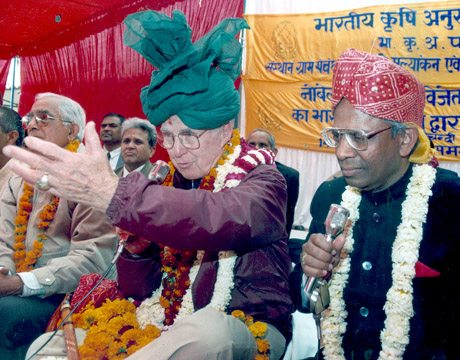 During 21-22 November, the
During 21-22 November, the 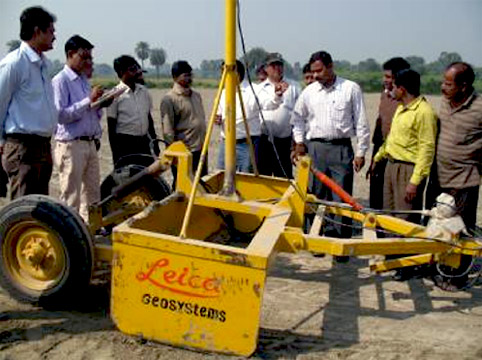 Nearly 20 delegates from North Bengal Agriculture University’s agricultural outreach stations and several local farmers attended a conservation agriculture (conservation agriculture) traveling training seminar in India during 29-30 October 2009.
Nearly 20 delegates from North Bengal Agriculture University’s agricultural outreach stations and several local farmers attended a conservation agriculture (conservation agriculture) traveling training seminar in India during 29-30 October 2009.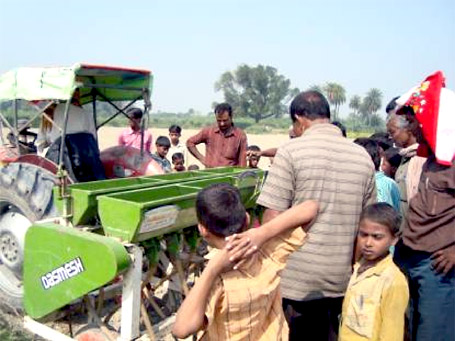 Participants then traveled to Rajendra Agriculture University’s (RAU), Pusa Farm, where they saw CA-based longterm experimental trials of rice-wheat and rice-maize systems. Following this, the delegation visited participatory trials of zero-till rice and listened to additional CA information and herbicide application techniques presented by CSISA hub manager Ravi Gopal. Finally, S. Chowdhury, CIMMYT seed production specialist, spoke about new wheat varieties suitable for the eastern Indo- Gangetic Plains.
Participants then traveled to Rajendra Agriculture University’s (RAU), Pusa Farm, where they saw CA-based longterm experimental trials of rice-wheat and rice-maize systems. Following this, the delegation visited participatory trials of zero-till rice and listened to additional CA information and herbicide application techniques presented by CSISA hub manager Ravi Gopal. Finally, S. Chowdhury, CIMMYT seed production specialist, spoke about new wheat varieties suitable for the eastern Indo- Gangetic Plains.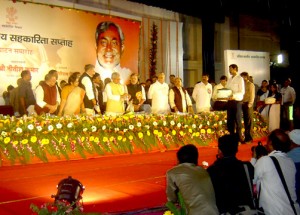 Tortillas made from quality protein maize (QPM) are now being sold on the streets in Patna, the capital city of Bihar, India. CIMMYT-India donated a QPM tortilla unit to Magadh Credit Cooperative Society (MCCS) and the society is now selling five tortillas with curry for about US$ 0.25 (10-12 rupees). The program is based on a “meals on wheels” scheme and the food will be sold at mobile shops and Sudha milk booths across Patna. The goal is to provide affordable, healthy food to the city’s urban poor. CIMMYT and Cereal System Initiative for South Asia (CSISA) are working to strengthen inbred production of hybrid QPM seed in eastern India to support this production chain.
Tortillas made from quality protein maize (QPM) are now being sold on the streets in Patna, the capital city of Bihar, India. CIMMYT-India donated a QPM tortilla unit to Magadh Credit Cooperative Society (MCCS) and the society is now selling five tortillas with curry for about US$ 0.25 (10-12 rupees). The program is based on a “meals on wheels” scheme and the food will be sold at mobile shops and Sudha milk booths across Patna. The goal is to provide affordable, healthy food to the city’s urban poor. CIMMYT and Cereal System Initiative for South Asia (CSISA) are working to strengthen inbred production of hybrid QPM seed in eastern India to support this production chain.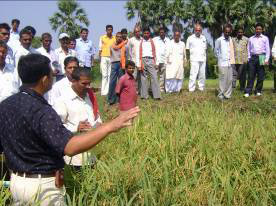 Three years of sowing experience with conservation agriculture (CA) practices in a rice-wheat system at an agricultural outreach station (KVK) in the Jamui district of Bihar State in India have been successful. So far, results show that dry, direct-seeded rice or transplanted rice on permanent beds give higher yields than other crop establishment methods, said KVK agronomist P.K. Singh to visitors during a CA farmer’s field day.
Three years of sowing experience with conservation agriculture (CA) practices in a rice-wheat system at an agricultural outreach station (KVK) in the Jamui district of Bihar State in India have been successful. So far, results show that dry, direct-seeded rice or transplanted rice on permanent beds give higher yields than other crop establishment methods, said KVK agronomist P.K. Singh to visitors during a CA farmer’s field day.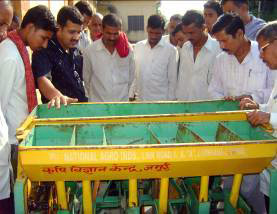 Later in the day, farmers viewed various plots sown with different CA practices, during which they asked questions and saw CA machinery demonstrations. Dry, direct-seeded rice with anchored residues in a permanent no-till system caught the attention of many participants, along with the high-yielding, unpuddled transplanted rice on permanent beds. Farmers also discussed weed management practices for various crops with Ravi Gopal, agronomist for the Cereal Systems Initiative for South Asia (CSISA). The event was part of CSISA’s delivery objective for the central Bihar Hub.
Later in the day, farmers viewed various plots sown with different CA practices, during which they asked questions and saw CA machinery demonstrations. Dry, direct-seeded rice with anchored residues in a permanent no-till system caught the attention of many participants, along with the high-yielding, unpuddled transplanted rice on permanent beds. Farmers also discussed weed management practices for various crops with Ravi Gopal, agronomist for the Cereal Systems Initiative for South Asia (CSISA). The event was part of CSISA’s delivery objective for the central Bihar Hub.